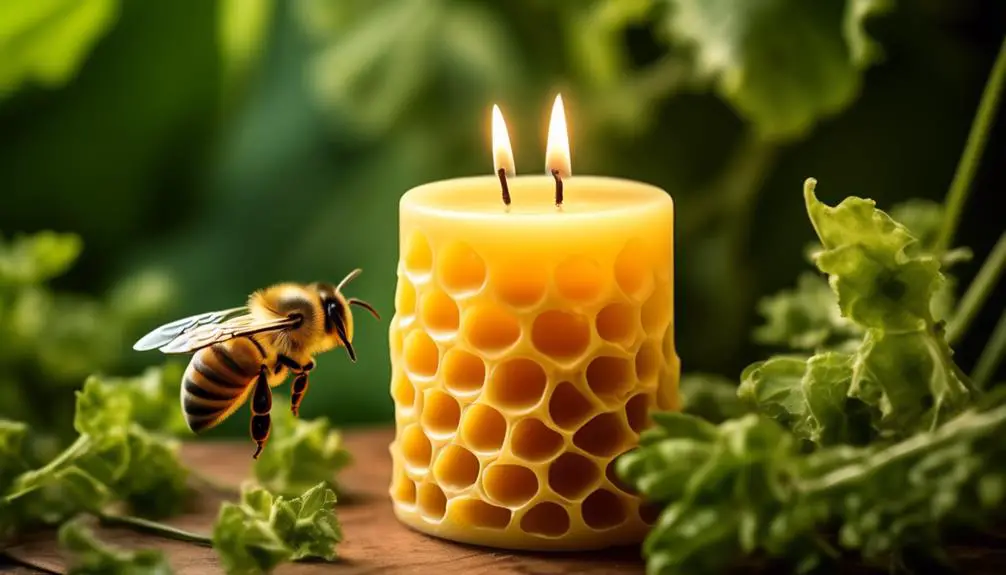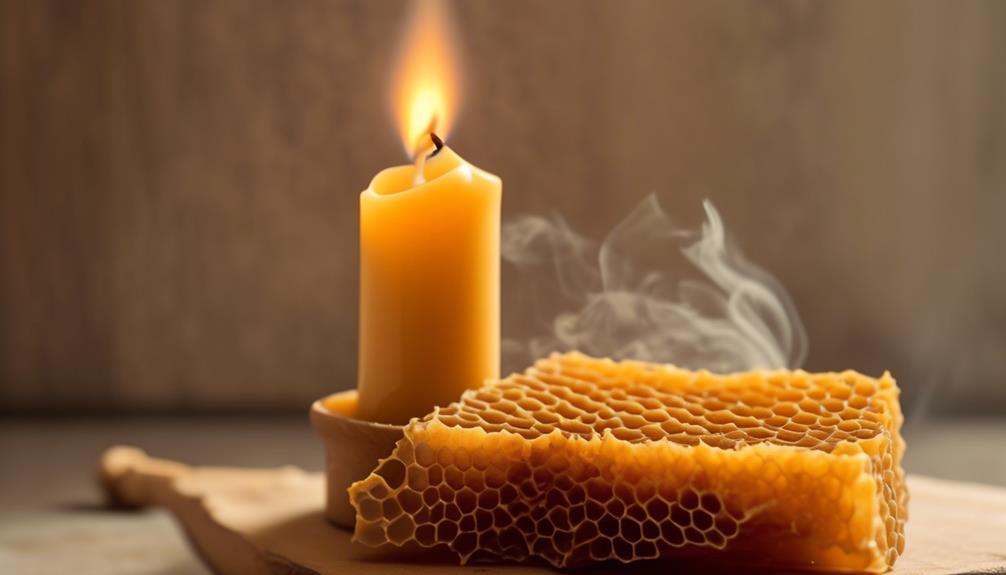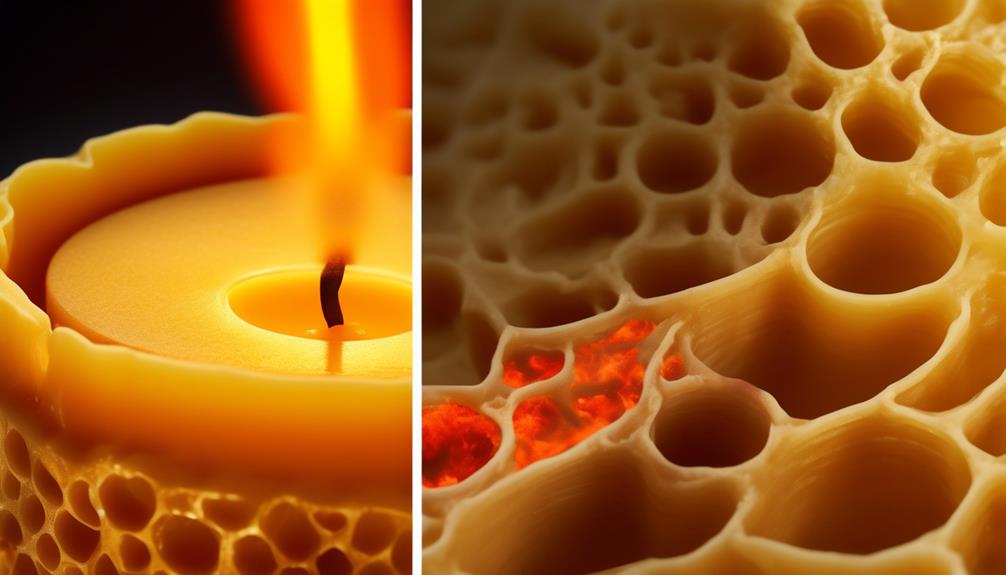Gain insights into the world of beeswax and discover whether it truly offers a clean-burning alternative for your candles and indoor air quality.

Does Beeswax Burn Clean?
Just like a bee buzzing tirelessly from flower to flower, you've probably found yourself seeking accurate information about whether beeswax burns clean. As you weigh your options for clean-burning materials, beeswax is a contender that's hard to dismiss.
But, does it really live up to the hype? Does the burning of beeswax release harmful toxins into your environment, or is it as natural and safe as it's often touted to be?
Keep in mind, the answer could significantly influence your next candle purchase decision or even impact your indoor air quality. So, brace yourself, as we're about to unmask the truth.
Key Takeaways
- Beeswax burns cleaner and brighter than paraffin and soy wax, producing virtually no soot or smoke.
- Beeswax has a slow, dripless burn, making it more economical in the long run.
- Burning beeswax candles can help purify the air and improve indoor air quality by emitting negative ions.
- Beeswax is a natural and environmentally friendly alternative to paraffin, with additional uses beyond candles.
Understanding Beeswax Composition

To fully grasp why beeswax burns so cleanly, you'll need to understand its unique composition. Beeswax is a natural wax produced by honey bees. It's primarily composed of fatty acids and long-chain alcohols, both of which contribute to its clean burn.
Firstly, the fatty acids in beeswax are hydrocarbons which, when burned, combine with oxygen to produce water (H2O) and carbon dioxide (CO2). This reaction isn't only efficient but also produces minimal smoke and soot, giving us a clean burn.
Secondly, the long-chain alcohols in beeswax serve as fuel for the flame. They burn slowly and completely, contributing to a longer burn time compared to other waxes. This slow burn also means less wax is consumed at a time, reducing waste and smoke.
Lastly, beeswax's melting point is higher than other waxes. It's about 62-64°C (144-147°F), which means it burns at a higher temperature. This high-temperature burn helps to ensure that the wax is burned completely, reducing the amount of unburned wax particles that can lead to soot.
The Combustion Process Explained

Understanding the composition of beeswax sets the stage for a deeper exploration of how exactly it burns so cleanly, an explanation rooted in the process of combustion.
When you light a beeswax candle, the heat of the flame melts the wax near the wick. This liquid wax is drawn up the wick where the heat of the flame vaporizes the liquid wax, turning it into a hot gas.
It's the vaporized gases that react with the oxygen in the air to create heat, light, water vapor, and carbon dioxide in a process known as combustion.
Now, the completeness of this combustion process is key to whether a substance burns cleanly or not. Ideally, you'd want all the gas to convert into water vapor and carbon dioxide, with no soot or smoke produced.
Compared to other waxes, beeswax is known to burn more completely, hence producing less soot. This is largely due to its unique composition and the presence of certain compounds that enhance the combustion process.
Comparing Beeswax With Other Waxes

When comparing beeswax to other waxes, like paraffin or soy, you'll find that beeswax's unique composition gives it a distinct advantage in terms of clean burning. Unlike paraffin, which produces black soot and releases toxins when burned, beeswax burns cleaner and brighter, with virtually no soot or smoke.
Beeswax's slow, dripless burn also sets it apart from other waxes. It's this characteristic that makes it a more economical choice in the long run, despite its higher upfront cost. Soy wax, while a cleaner burning option than paraffin, doesn't hold a candle to beeswax when it comes to burn time.
Also, beeswax emits negative ions that help purify the air, unlike other waxes. It's this feature that makes it a beneficial choice for people with allergies, asthma, or other respiratory conditions.
Lastly, beeswax's natural fragrance, derived from the honey and flower nectar in the honeycomb, is another key advantage. While other waxes require artificial scents, beeswax offers a subtle, pleasant aroma without any added chemicals.
Health Implications of Beeswax Burning

As you light a beeswax candle, it's important to consider the potential health implications that arise from its clean burn. Contrary to paraffin candles, beeswax candles don't release toxins or soot into the air when burned. This can make a significant difference for your respiratory health, especially if you have conditions like asthma or allergies.
The natural properties of beeswax facilitate the emission of negative ions when heated. These ions can help purify the air by binding with positive ions – often found in dust, mold, and other allergens – and removing them. This action can improve air quality and contribute to a healthier indoor environment.
Despite the positive aspects, you shouldn't overlook potential risks. Some people may have an inherent sensitivity to beeswax, which could cause allergic reactions when burning beeswax candles. Symptoms can include sneezing, nasal congestion, or skin irritation.
Tips for Burning Beeswax Candles Safely

Despite the potential sensitivity some people may have to beeswax, you can still enjoy the benefits of these candles by following certain safety measures.
First, always burn candles in a well-ventilated area. Beeswax candles burn clean, but they do emit a natural scent that some people may find overwhelming in close quarters.
Second, never leave a burning candle unattended. This rule applies to all candles, not just beeswax. Accidental fires can happen if a candle is left burning unattended, especially if it's near flammable items.
Third, trim the wick to a quarter inch before each use. This minimizes soot and smoke, ensuring a cleaner burn. Keeping the wick trimmed also prevents it from flickering and sparking, which can be fire hazards.
Lastly, always burn candles on a heat-resistant surface. Beeswax candles can get hot, and if placed on a flammable surface, they can cause it to catch fire.
Frequently Asked Questions
Can Beeswax Candles Cause Allergies?
You might be wondering if beeswax candles can cause allergies. It's generally rare, but not impossible. If you're particularly sensitive, you could react to the natural pollen and honey content in the wax.
However, beeswax candles are often a better choice than their paraffin counterparts, as they don't release harmful toxins.
But remember, it's always important to monitor your reactions when introducing new products into your home.
How Is Beeswax Harvested for Candle Making?
You're curious about how beeswax is harvested for candle making. It's quite the process!
Beekeepers collect honeycomb from the hives, then they scrape off the caps, leaving just the comb.
They rinse, melt and strain this comb to remove any debris, resulting in pure beeswax.
It's a labor-intensive, but sustainable process, ensuring you're getting a high-quality, natural product for your candles.
Isn't it fascinating to see the journey from hive to home?
Can Burning Beeswax Candles Damage Household Items?
You're wondering if burning beeswax candles can damage household items. Rest assured, when used properly, they won't. Beeswax candles actually burn cleaner than paraffin candles, emitting fewer toxins and soot.
However, it's still important to follow safety guidelines. Never leave a burning candle unattended, and keep it away from flammable items. So, while beeswax candles can be a safer choice, it doesn't eliminate the need for candle safety.
How Long Does a Beeswax Candle Typically Burn For?
You're probably wondering how long a beeswax candle typically lasts. It's surprisingly long-lasting! A beeswax candle can burn for roughly 20 hours per inch of its length. This is because beeswax has a higher melting point than other waxes.
You'll get a slow, steady burn, and more value for your dollar. Don't forget, though, that the burn time can vary based on the candle's shape and size.
Are There Any Ethical Concerns Associated With Using Beeswax?
Yes, there are ethical concerns associated with using beeswax.
You see, beeswax production can sometimes harm bees. Overharvesting can deplete a hive's resources, leading to malnourishment or even colony collapse.
Beeswax isn't always sourced sustainably or ethically. It's crucial to buy beeswax products from reputable sources that prioritize bee health and sustainable farming practices.
Conclusion
In conclusion, beeswax does burn clean, emitting minimal soot and no harmful by-products. It outperforms other waxes, especially paraffin, which releases toxins when burnt.
But, remember, beeswax's clean burn still requires proper candle care. Trim the wick, avoid drafts, and let it burn long enough to avoid tunneling.
Enjoy the warm glow of beeswax candles, knowing you're making a healthier choice for your home.



